Garmin G500 User Manual
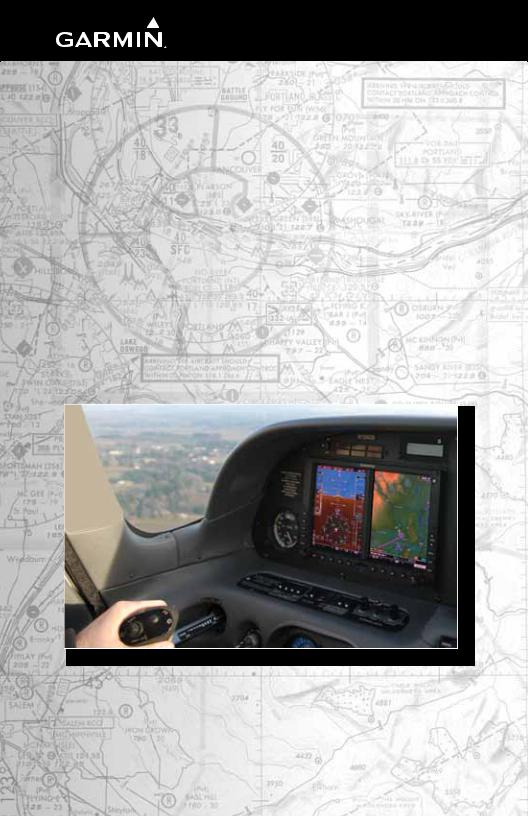
G500
Pilot’s
Guide
© 2012 Garmin Ltd. or its subsidiaries. All rights reserved.
This manual reflects the operation of System Software version 6.11, or later. Some differences in operation may be observed when comparing the information in this manual to later software versions.
Garmin International, Inc., 1200 East 151st Street, Olathe, KS 66062, U.S.A.
Tel: 913/397.8200 |
Fax: 913/397.8282 |
Garmin AT, Inc., 2345 Turner Road SE, Salem, OR 97302, U.S.A. |
|
Tel: 503/391.3411 |
Fax 503/364.2138 |
Garmin (Europe) Ltd., Liberty House, Bulls Copse Road, Hounsdown Business Park, Southampton, |
|
SO40 9RB, U.K. |
|
Tel. +44 (0) 870 850 1243 |
Fax +44 (0) 238 052 4004 |
Garmin Corporation, No. 68, Zhangshu 2nd Road, Xizhi Dist., New Taipei City 221, Taiwan (R.O.C.)
Tel: 886/02.2642.9199 |
Fax: 886/02.2642.9099 |
Garmin Singapore Pte. Ltd., 46 East Coast Road, #05-06 Eastgate, Singapore 428766 |
|
Tel : (65) 63480378 |
Fax : ( 65 ) 63480278 |
At Garmin, we value your opinion. For comments about this guide, please e-mail: Techpubs.Salem@Garmin.com
www.garmin.com
Except as expressly provided herein, no part of this manual may be reproduced, copied, transmitted, disseminated, downloaded or stored in any storage medium, for any purpose without the express written permission of Garmin. Garmin hereby grants permission to download a single copy of this manual and of any revision to this manual onto a hard drive or other electronic storage medium to be viewed for personal use, provided that such electronic or printed copy of this manual or revision must contain the complete text of this copyright notice and provided further that any unauthorized commercial distribution of this manual or any revision hereto is strictly prohibited.
Garmin®, FliteCharts®, and SafeTaxi® are registered trademarks of Garmin Ltd. or its subsidiaries. Garmin SVT™ is a trademark of Garmin Ltd. or its subsidiaries. These trademarks may not be used without the express permission of Garmin.
NavData® is a registered trademark of Jeppesen, Inc.; SkyWatch® is a registered trademark of L-3 Avionics Systems; Sirius and XM are trademarks of Sirius XM Radio Inc.; Iridium® is a registered trademark of Iridium Communications Inc.; United States radar data provided by NOAA; Canadian radar data provided by Environment Canada; European radar data collected and provided by Meteo France.
August 2012 |
Printed in the U.S.A. |

AVIATION LIMITED WARRANTY
All Garmin avionics products are warranted to be free from defects in materials or workmanship for: two years from the date of purchase for new Remote-Mount and Panel-Mount products; one year from the date of purchase for new portable products and any purchased newly-overhauled products; six months for newly-overhauled products exchanged through a Garmin Authorized Service Center; and 90 days for factory repaired or newly-overhauled products exchanged at Garmin in lieu of repair. Within the applicable period, Garmin will, at its sole option, repair or replace any components that fail in normal use. Such repairs or replacement will be made at no charge to the customer for parts or labor, provided that the customer shall be responsible for any transportation cost. This warranty does not apply to: (i) cosmetic damage, such as scratches, nicks and dents; (ii) consumable parts, such as batteries, unless product damage has occurred due to a defect in materials or workmanship; (iii) damage caused by accident, abuse, misuse, water, flood, fire, or other acts of nature or external causes; (iv) damage caused by service performed by anyone who is not an authorized service provider of Garmin; or (v) damage to a product that has been modified or altered without the written permission of Garmin. In addition, Garmin reserves the right to refuse warranty claims against products or services that are obtained and/or used in contravention of the laws of any country.
THE WARRANTIES AND REMEDIES CONTAINED HEREIN ARE EXCLUSIVE AND IN LIEU OF ALL OTHER WARRANTIES, WHETHER EXPRESS, IMPLIED OR STATUTORY, INCLUDING ANY LIABILITY ARISING UNDER ANY WARRANTY OF MERCHANTABILITY OR FITNESS FOR A PARTICULAR PURPOSE, STATUTORY OR OTHERWISE. THIS WARRANTY GIVES YOU SPECIFIC LEGAL RIGHTS, WHICH MAY VARY FROM STATE TO STATE.
INNOEVENTSHALLGARMINBELIABLEFORANYINCIDENTAL,SPECIAL,INDIRECTORCONSEQUENTIAL DAMAGES, WHETHER RESULTING FROM THE USE, MISUSE OR INABILITY TO USE THE PRODUCT OR FROM DEFECTS IN THE PRODUCT. SOME STATES DO NOT ALLOW THE EXCLUSION OF INCIDENTAL OR CONSEQUENTIAL DAMAGES, SO THE ABOVE LIMITATIONS MAY NOT APPLY TO YOU.
Garmin retains the exclusive right to repair or replace (with a new or newly-overhauled replacement product) the product or software or offer a full refund of the purchase price at its sole discretion. SUCH REMEDY SHALL BE YOUR SOLE AND EXCLUSIVE REMEDY FOR ANY BREACH OF WARRANTY.
Online Auction Purchases: Products purchased through online auctions are not eligible for warranty coverage. Online auction confiirmations are not accepted for warranty verifiication.To obtain warranty service, an original or copy of the sales receipt from the original retailer is required. Garmin will not replace missing components from any package purchased through an online auction.
International Purchases: A separate warranty may be provided by international distributors for devices purchased outside the United States depending on the country. If applicable, this warranty is provided by the local in-country distributor and this distributor provides local service for your device. Distributor warranties are only valid in the area of intended distribution. Devices purchased in the United States or Canada must be returned to the Garmin service center in the United Kingdom, the United States, Canada, or Taiwan for service.
To obtain warranty service, contact your local Garmin Authorized Service Center. For assistance in locating a Service Center near you, visit the Garmin web site at http://www.garmin.com or contact Garmin Customer Service at 866-739-5687.
Foreward |
|
|
System |
1 Sec |
|
PFD |
2 Sec |
|
3 Sec MFD |
|
|
Avoidance |
Hazard |
4 Sec |
Features |
Additional |
5 Sec |
Alerts & |
.Annun |
6 Sec |
Symbols |
7 Sec |
|
Glossary |
8 Sec |
|
A Appendix |
|
|
Index |
Appendix |
|
|
B |
|
190-01102-02 Rev. E |
Garmin G500 Pilot’s Guide |
i |

|
|
Foreword |
|
|
|
|
Sec 1 |
System |
|
Sec 2 |
PFD |
|
Sec 3 |
MFD |
Sec 4 |
Hazard |
Avoidance |
Sec 5 |
Additional |
Features |
Sec 6 |
Annun. & Alerts |
|
|
Sec 7 |
Symbols |
|
Sec 8 |
Glossary |
|
|
Appendix A |
|
Appendix B |
Index |
WARNING: Navigation and terrain separation must NOT be predicated upon the use of the terrain function. The G500 Terrain Proximity feature is NOT intended to be used as a primary reference for terrain avoidance and does not relieve the pilot from the responsibility of being aware of surroundings during flight. The Terrain Proximity feature is only to be used as an aid for terrain avoidance and is not certified for use in applications requiring a certified terrain awareness system. Terrain data is obtained from third party sources. Garmin is not able to independently verify the accuracy of the terrain data.
WARNING: The displayed minimum safe altitudes (MSAs) are only advisory in nature and should not be relied upon as the sole source of obstacle and terrain avoidance information. Always refer to current aeronautical charts for appropriate minimum clearance altitudes.
WARNING: The Garmin G500 has a very high degree of functional integrity. However, the pilot must recognize that providing monitoring and/or selftest capability for all conceivable system failures is not practical.Although unlikely, it may be possible for erroneous operation to occur without a fault indication shown by the G500. It is thus the responsibility of the pilot to detect such an occurrence by means of cross-checking with all redundant or correlated information available in the cockpit.
WARNING: The altitude calculated by GPS receivers is geometric height above Mean Sea Level and could vary significantly from the altitude displayed by pressure altimeters, such as the output from the GDC 74A Air Data Computer, or other altimeters in aircraft. GPS altitude should never be used for vertical navigation. Always use pressure altitude displayed by the G500 PFD or other pressure altimeters in aircraft.
WARNING: Do not use outdated database information. Databases used in the G500 system must be updated regularly in order to ensure that the information remains current. Pilots using an outdated database do so entirely at their own risk.
WARNING: Do not use basemap (land and water data) information for primary navigation. Basemap data is intended only to supplement other approved navigation data sources and should be considered as an aid to enhance situational awareness.
ii |
Garmin G500 Pilot’s Guide |
190-01102-02 Rev. E |
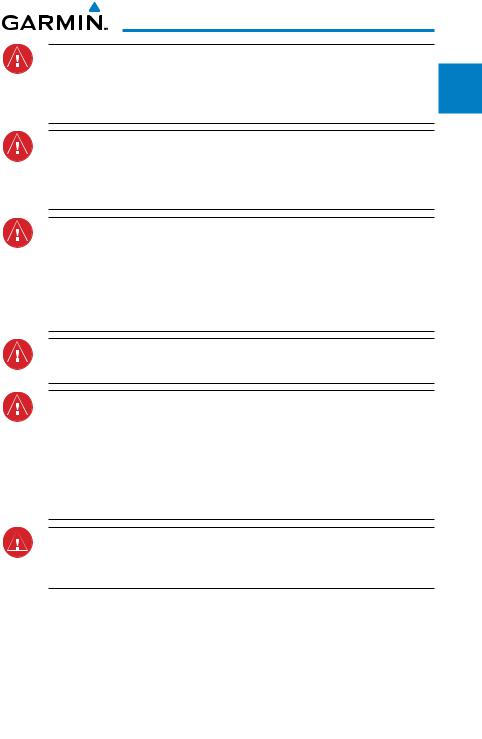
WARNING: Traffic information shown on the G500 Multi Function Display is provided as an aid in visually acquiring traffic. Pilots must maneuver the aircraft based only upon ATC guidance or positive visual acquisition of conflicting traffic.
WARNING: Do not use data link weather information for maneuvering in, near, or around areas of hazardous weather. Information contained within data link weather products may not accurately depict current weather conditions.
WARNING: Do not use the indicated data link weather product age to determine the age of the weather information shown by the data link weather product. Due to time delays inherent in gathering and processing weather data for data link transmission, the weather information shown by the data link weather product may be significantly older than the indicated weather product age.
WARNING: For safety reasons, G500 operational procedures must be learned on the ground.
WARNING: To reduce the risk of unsafe operation, carefully review and understand all aspects of the G500 Pilot’s Guide. Thoroughly practice basic operation prior to actual use. During flight operations, carefully compare indications from the G500 to all available navigation sources, including the information from other NAVAIDs, visual sightings, charts, etc. For safety purposes, always resolve any discrepancies before continuing navigation.
WARNING: Exceeding 200 deg/second in pitch or roll may invalidate AHRS attitude provided to the G500. Exceeding 450 KIAS may invalidate ADC information provided to the G500.
Foreward |
|
|
System |
1 Sec |
|
PFD |
2 Sec |
|
3 Sec MFD |
|
|
Avoidance |
Hazard |
4 Sec |
Features |
Additional |
5 Sec |
Alerts & |
.Annun |
6 Sec |
Symbols |
7 Sec |
|
Glossary |
8 Sec |
|
A Appendix |
|
|
Index |
Appendix |
|
|
B |
|
190-01102-02 Rev. E |
Garmin G500 Pilot’s Guide |
iii |
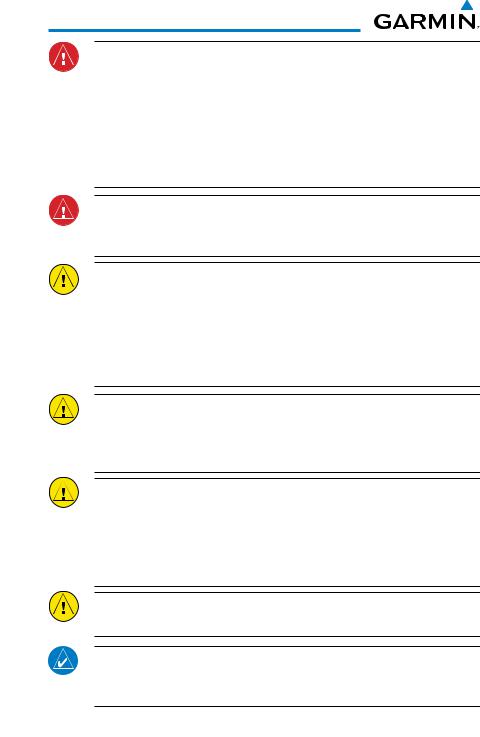
|
|
Foreword |
|
|
|
|
Sec 1 |
System |
|
Sec 2 |
PFD |
|
Sec 3 |
MFD |
Sec 4 |
Hazard |
Avoidance |
Sec 5 |
Additional |
Features |
Sec 6 |
Annun. & Alerts |
|
|
Sec 7 |
Symbols |
|
Sec 8 |
Glossary |
|
|
Appendix A |
|
Appendix B |
Index |
WARNING: Because of anomalies in the earth’s magnetic field, operating the G500 within the following areas could result in loss of reliable attitude and heading indications. North of 70° North latitude and south of 70° South latitude. An area north of 65° North latitude and between longitude 75° West and 120° West. An area north of 70° North latitude and between longitude 70° West and 128° West.An area north of 70° North latitude and between longitude 85° East and 114° West. An area south of 55° South latitude between longitude 120° East and 165° East.
WARNING: Do not use Terrain-SVT information for primary terrain avoidance. Terrain-SVT is intended only to enhance situational awareness.
CAUTION: The United States government operates the Global Positioning System and is solely responsible for its accuracy and maintenance. The GPS system is subject to changes which could affect the accuracy and performance of all GPS equipment. Portions of the Garmin G500 utilize GPS as a precision electronic NAVigation AID (NAVAID). Therefore, as with all NAVAIDs, information presented by the G500 can be misused or misinterpreted and, therefore, become unsafe.
CAUTION: The Garmin G500 does not contain any user-serviceable parts. Repairs should only be made by an authorized Garmin service center. Unauthorized repairs or modifications could void both the warranty and the pilot’s authority to operate this device under FAA/FCC regulations.
CAUTION: The G500 PFD and MFD displays use a lens coated with a special anti-reflective coating that is very sensitive to skin oils, waxes, and abrasive cleaners. CLEANERS CONTAINING AMMONIA WILL HARM THE ANTI-REFLECTIVE COATING. It is very important to clean the lens using a clean, lint-free cloth and an eyeglass lens cleaner that is specified as safe for anti-reflective coatings.
CAUTION: When interfaced with a GSR56 Iridium transceiver only one SD card may be present in the GDU620 and it must be in the lower slot.
NOTE: Do not rely solely upon data link services to provide Temporary Flight Restriction (TFR) information. Always confirm TFR information through official sources such as Flight Service Stations or Air Traffic Control.
iv |
Garmin G500 Pilot’s Guide |
190-01102-02 Rev. E |

NOTE: Interference from GPS repeaters operating inside nearby hangars can cause an intermittent loss of attitude and heading displays while the aircraft is on the ground. Moving the aircraft more than 100 feet away from the source of the interference should alleviate the condition.
NOTE: All visual depictions contained within this document, including screen images of the G500 bezel and displays, are subject to change and may not reflect the most current GDU 620 system. Depictions of equipment may differ slightly from the actual equipment.
NOTE: This device complies with part 15 of the FCC Rules. Operation is subject to the following two conditions: (1) this device may not cause harmful interference, and (2) this device must accept any interference received, including interference that may cause undesired operation.
NOTE: Terrain data is not displayed when the aircraft latitude is greater than 75° North or 60° South.
NOTE: This product, its packaging, and its components contain chemicals known to the State of California to cause cancer, birth defects, or reproductive harm. This notice is being provided in accordance with California’s Proposition 65. If you have any questions or would like additional information, please refer to our web site at www.garmin.com/ prop65.
NOTE: Terrain-SVT is standard when the Garmin Synthetic Vision Technology™ (SVT) option is installed.
NOTE: Do not use SafeTaxi or Chartview functions as the basis for ground maneuvering. SafeTaxi and Chartview functions have not been qualified to be used as an airport moving map display (AMMD). SafeTaxi and Chartview are intended to improve pilot situational awareness during ground operations should only be used by the flight crew to orient themselves on the airport surface.
Foreward |
|
|
System |
1 Sec |
|
PFD |
2 Sec |
|
3 Sec MFD |
|
|
Avoidance |
Hazard |
4 Sec |
Features |
Additional |
5 Sec |
Alerts & |
.Annun |
6 Sec |
Symbols |
7 Sec |
|
Glossary |
8 Sec |
|
A Appendix |
|
|
Index |
Appendix |
|
|
B |
|
190-01102-02 Rev. E |
Garmin G500 Pilot’s Guide |
v |

|
|
Foreword |
|
Sec 1 |
System |
|
Sec 2 |
PFD |
|
Sec 3 |
MFD |
Sec 4 |
Hazard |
Avoidance |
Sec 5 |
Additional |
Features |
Sec 6 |
Annun. & Alerts |
|
|
Sec 7 |
Symbols |
|
Sec 8 |
Glossary |
|
|
Appendix A |
|
Appendix B |
Index |
Record of Revisions
Part Number |
Revision |
Date |
Description |
190-01102-02 |
A |
6/1/09 |
Production release |
|
|
|
|
|
B |
6/17/09 |
Formatting changes |
|
|
|
|
|
C |
11/19/10 |
Updates for SW Versions 4.00 and 5.00 |
|
|
|
|
|
D |
08/05/11 |
Updates for SW Version 6.00 |
|
|
|
|
|
E |
10/19/12 |
Updates for SW Version 6.11 |
|
|
|
|
AOPA Airport Directory
AOPA MEMBERSHIP PUBLICATIONS, INC. AND ITS RELATED ORGANIZATIONS (HEREINAFTER COLLECTIVELY "AOPA") EXPRESSLY DISCLAIM ALL WARRANTIES, WITH RESPECT TO THE AOPA INFORMATION INCLUDED IN THIS DATA, EXPRESS OR IMPLIED, INCLUDING, BUT NOT LIMITED TO, THE IMPLIED WARRANTIES OF MERCHANTABILITY AND FITNESS FOR A PARTICULAR PURPOSE. THE INFORMATION IS PROVIDED “AS IS” AND AOPA DOES NOT WARRANT OR MAKE ANY REPRESENTATIONS REGARDING ITS ACCURACY, RELIABILITY, OR OTHERWISE. UNDER NO CIRCUMSTANCES INCLUDING NEGLIGENCE, SHALL AOPA BE LIABLE FOR ANY INCIDENTAL, SPECIAL OR CONSEQUENTIAL DAMAGES THAT RESULT FROM THE USE OR INABILITY TO USE THE SOFTWARE OR RELATED DOCUMENTATION, EVEN IF AOPA OR AN AOPA AUTHORIZED REPRESENTATIVE HAS BEEN ADVISED OF THE POSSIBILITY OF SUCH DAMAGES. USER AGREES NOT TO SUE AOPA
AND, TO THE MAXIMUM EXTENT ALLOWED BY LAW, TO RELEASE AND HOLD HARMLESS AOPA FROM ANY CAUSES OF ACTION, CLAIMS OR LOSSES RELATED TO ANY ACTUAL OR ALLEGED INACCURACIES IN THE INFORMATION. SOME JURISDICTIONS DO NOT ALLOW THE LIMITATION OR EXCLUSION OF IMPLIED WARRANTIES OR LIABILITY FOR INCIDENTAL OR CONSEQUENTIAL DAMAGES SO THE ABOVE LIMITATIONS OR EXCLUSIONS MAY NOT APPLY TO YOU.
vi |
Garmin G500 Pilot’s Guide |
190-01102-02 Rev. E |

|
|
Contents |
|
1 |
System Overview.................................................................................. |
1-1 |
|
1.1 |
System Description................................................................................ |
1-1 |
|
|
1.1.1 |
Line Replaceable Units (LRU).................................................. |
1-2 |
|
1.1.2 |
GDU 620............................................................................... |
1-3 |
|
1.1.3 |
GDC 74A............................................................................... |
1-4 |
|
1.1.4 |
GRS 77.................................................................................. |
1-4 |
|
1.1.5 |
GMU 44................................................................................ |
1-5 |
|
1.1.6 |
GTX 330/330D (Optional)...................................................... |
1-5 |
|
1.1.7 |
GTP 59.................................................................................. |
1-5 |
|
1.1.8 |
GSR 56.................................................................................. |
1-5 |
|
1.1.9 |
GDL 69/69A (Optional).......................................................... |
1-6 |
|
1.1.10 |
GAD 43(e) (Optional)............................................................. |
1-6 |
|
1.1.11 |
Weather Radar....................................................................... |
1-7 |
|
1.1.12 |
Garmin Navigator Interface.................................................... |
1-7 |
|
1.1.13 |
Attitude Heading Reference System (AHRS)............................ |
1-7 |
|
1.1.14 |
Secure Digital Cards............................................................. |
1-10 |
1.2 |
System Power Up................................................................................. |
1-11 |
|
1.3 International Geomagnetic Reference Field.......................................... |
1-13 |
||
1.4 |
System Operation................................................................................ |
1-14 |
|
|
1.4.1 |
Pilot Controls....................................................................... |
1-14 |
|
1.4.1.1 |
PFD Knob............................................................................ |
1-14 |
|
1.4.1.2 |
PFD Bezel Keys..................................................................... |
1-15 |
|
1.4.1.3 |
MFD Knobs.......................................................................... |
1-17 |
|
1.4.1.4 |
MFD Bezel Keys................................................................... |
1-17 |
|
1.4.2 |
Using the Soft Key Controls.................................................. |
1-18 |
|
1.4.3 |
Using the Page Menus......................................................... |
1-19 |
|
1.4.4 |
System Settings.................................................................... |
1-20 |
|
1.4.5 |
Display Backlighting............................................................. |
1-23 |
2 Primary Flight Display (PFD)................................................................. |
2-1 |
||
2.1 |
PFD Soft Keys........................................................................................ |
2-2 |
|
2.2 |
Airspeed Indicator................................................................................. |
2-5 |
|
|
2.2.1 |
Markings............................................................................... |
2-7 |
|
2.2.2 |
Reference Speeds................................................................... |
2-8 |
2.3 |
Attitude Indicator.................................................................................. |
2-9 |
|
Foreward |
|
|
System |
1 Sec |
|
PFD |
2 Sec |
|
3 Sec MFD |
|
|
Avoidance |
Hazard |
4 Sec |
Features |
Additional |
5 Sec |
Alerts & |
.Annun |
6 Sec |
Symbols |
7 Sec |
|
Glossary |
8 Sec |
|
A Appendix |
|
|
Index |
Appendix |
|
|
B |
|
190-01102-02 Rev. E |
Garmin G500 Pilot’s Guide |
vii |

|
|
Foreword |
|
Sec 1 |
System |
|
Sec 2 |
PFD |
|
Sec 3 |
MFD |
Sec 4 |
Hazard |
Avoidance |
Sec 5 |
Additional |
Features |
Sec 6 |
Annun. & Alerts |
|
|
Sec 7 |
Symbols |
|
Sec 8 |
Glossary |
|
|
Appendix A |
|
Appendix B |
Index |
|
2.3.1 |
Extreme Attitude .................................................................. |
2-11 |
2.4 |
Altimeter |
............................................................................................. |
2-13 |
|
2.4.1 ..................................... |
Setting the Altitude Bug and Alerter |
2-13 |
|
2.4.2 ................................................................... |
Altitude Alerting |
2-14 |
|
2.4.3 ................................................ |
Changing Barometric Setting |
2-15 |
|
2.4.4 .............. |
Minimum Descent Altitude/Decision Height Alerting |
2-15 |
2.5 |
Vertical Speed ...............................................................(V/S) Indicator |
2-18 |
|
2.6 |
Horizontal ............................................................Situational Indicator |
2-19 |
|
|
2.6.1 ...................................................... |
Setting the Heading Bug |
2-20 |
|
2.6.2 ............................................................... |
Turn Rate Indicator |
2-21 |
2.7 |
Course Deviation ...................................................................Indicator |
2-21 |
|
|
2.7.1 .......................................................... |
Changing CDI Sources |
2-22 |
|
2.7.2 ........................................................... |
Changing CDI Course |
2-23 |
|
2.7.3 .......................................... |
Vertical Deviation Indicator (VDI) |
2-24 |
|
2.7.4 ....................................................................... |
Auto - Slewing |
2-25 |
2.8 |
Supplemental .....................................................................Flight Data |
2-27 |
|
|
2.8.1 ................................................................... |
Bearing Pointers |
2-27 |
|
2.8.2 ............................................................. |
Temperature Display |
2-29 |
|
2.8.3 ........................................................................ |
Wind Vectors |
2-29 |
|
2.8.4 .................................................................... |
DME Indication |
2-29 |
|
2.8.5 .............................................. |
Marker Beacon Annunciations |
2-30 |
|
2.8.6 .................................................. |
Miscompare Annunciations |
2-30 |
2.9 |
Radar Altimeter................................................................................... |
2-32 |
|
2.10 Fast/Slow .............................................................................Indication |
2-33 |
||
2.11 PFD Display ................................................................................Units |
2-34 |
||
3 |
Multi-Function ...............................................................Display (MFD) |
3-1 |
|
3.1 |
Functional .........................................................................Display Map |
3-2 |
|
3.2 |
MFD Soft .................................................................................Key Map |
3-3 |
|
3.3 |
Navigation ...........................................................................Map Pages |
3-4 |
|
|
3.3.1 ................................................. |
Default Navigation Map Page |
3-5 |
|
3.3.2 ................................................................ |
Editing Information |
3-5 |
|
3.3.3 ........................................................... |
Selecting Page Options |
3-5 |
|
3.3.4 ..................................... |
Changing the Navigation Map Range |
3-5 |
|
3.3.5 ......................................................... |
Decluttering Map Pages |
3-6 |
|
3.3.6 ................................................................................. |
Panning |
3-8 |
|
3.3.7 .................................................... |
Selecting Items on the Map |
3-9 |
|
3.3.8 ............................................................ |
Measuring Distances |
3-10 |
viii |
Garmin G500 Pilot’s Guide |
190-01102-02 Rev. E |

3.3.9 |
Customizing Navigation Map Pages..................................... |
3-11 |
3.3.10 |
Map Setup........................................................................... |
3-11 |
3.3.10.1 |
Map Feature Options........................................................... |
3-13 |
3.3.10.2 |
Weather Feature Options (Optional)..................................... |
3-27 |
3.3.10.3 |
Traffic Feature Options (Optional)......................................... |
3-30 |
3.3.10.4 |
Aviation Feature Options...................................................... |
3-31 |
3.3.11 |
Split Screen (Optional).......................................................... |
3-42 |
3.4 Aux Mode Pages................................................................................. |
3-43 |
|
3.4.1 |
System Settings.................................................................... |
3-43 |
3.4.1.1 |
Display Brightness................................................................ |
3-44 |
3.4.1.2 |
Airspeed Reference Marks.................................................... |
3-45 |
3.4.1.3 |
PFD Options - Wind Vector................................................... |
3-46 |
3.4.1.4 |
PFD Options - Nav Status..................................................... |
3-47 |
3.4.1.5 |
Synchronization (Dual Installations Only).............................. |
3-48 |
3.4.1.6 |
Date and Time...................................................................... |
3-50 |
3.4.1.7 |
MFD Display Units................................................................ |
3-51 |
3.4.1.8 |
System Display Units............................................................ |
3-52 |
3.4.2 |
Sirius XM Satellite Radio XM Information (Optional)............. |
3-53 |
3.4.3Sirius XM Satellite Radio XM Entertainment Radio (Optional).3-54
3.4.4 |
System Status...................................................................... |
3-55 |
3.4.5 |
External Video (optional)...................................................... |
3-56 |
3.4.5.1 |
Select Video Source.............................................................. |
3-56 |
3.4.5.2 |
Zoom................................................................................... |
3-57 |
3.4.5.3 |
Panning............................................................................... |
3-57 |
3.4.5.4 |
Setup................................................................................... |
3-57 |
3.4.5.5 |
Restore Defaults................................................................... |
3-59 |
3.4.6 |
Position Reporting (optional)................................................ |
3-60 |
3.4.6.1 |
Status.................................................................................. |
3-60 |
3.4.6.2 |
Report Type.......................................................................... |
3-60 |
3.4.7 |
Iridium Phone Operation (Optional)...................................... |
3-63 |
3.4.7.1 |
Status.................................................................................. |
3-63 |
3.4.7.2 |
Managing the Phone Book................................................... |
3-65 |
3.4.7.3 |
Phone Volume...................................................................... |
3-68 |
3.4.7.4 |
Making a Phone Call............................................................ |
3-69 |
3.4.7.5 |
Answering a Phone Call....................................................... |
3-70 |
3.5 Flight Plan Pages................................................................................. |
3-71 |
|
3.5.1 |
Active Flight Plan Page......................................................... |
3-71 |
3.5.1.1 |
Active Flight Plan Detail....................................................... |
3-72 |
Foreward |
|
|
System |
1 Sec |
|
PFD |
2 Sec |
|
3 Sec MFD |
|
|
Avoidance |
Hazard |
4 Sec |
Features |
Additional |
5 Sec |
Alerts & |
.Annun |
6 Sec |
Symbols |
7 Sec |
|
Glossary |
8 Sec |
|
A Appendix |
|
|
Index |
Appendix |
|
|
B |
|
190-01102-02 Rev. E |
Garmin G500 Pilot’s Guide |
ix |

|
|
Foreword |
|
Sec 1 |
System |
|
Sec 2 |
PFD |
|
Sec 3 |
MFD |
Sec 4 |
Hazard |
Avoidance |
Sec 5 |
Additional |
Features |
Sec 6 |
Annun. & Alerts |
|
|
Sec 7 |
Symbols |
|
Sec 8 |
Glossary |
|
|
Appendix A |
|
Appendix B |
Index |
|
3.5.1.2 |
Active Flight Plan Options.................................................... |
3-72 |
|
3.5.1.3 |
Setting the Altitude Minimums Alerter.................................. |
3-73 |
|
3.5.2 |
Waypoint Information Page.................................................. |
3-74 |
|
3.5.2.1 |
Selecting a Waypoint............................................................ |
3-75 |
|
3.5.2.2 |
Waypoint Information Detail................................................. |
3-76 |
|
3.5.2.3 |
Airport Directory.................................................................. |
3-79 |
|
3.5.2.4 |
Waypoint Weather Information (Optional)............................. |
3-80 |
|
3.5.3 |
Charts Page (Optional)......................................................... |
3-81 |
|
3.5.3.1 |
Viewing Charts.................................................................... |
3-82 |
|
3.5.3.2 |
Selecting a New Chart by Airport.......................................... |
3-83 |
|
3.5.3.3 |
Selecting a New Chart by FPL, NRST, or RECENT................... |
3-84 |
|
3.5.3.4 |
Change Day/Night View....................................................... |
3-84 |
4 |
Hazard Avoidance................................................................................. |
4-1 |
|
4.1 |
Terrain Configurations........................................................................... |
4-1 |
|
4.2 |
Terrain Scale.......................................................................................... |
4-3 |
|
4.3 |
Terrain Proximity.................................................................................... |
4-3 |
|
|
4.3.1 |
Displaying Terrain Proximity.................................................... |
4-4 |
|
4.3.1.1 |
Terrain Proximity Page Display on the Terrain Page.................. |
4-4 |
|
4.3.1.2 |
Terrain Proximity Page Display on a Navigation Map Page....... |
4-5 |
|
4.3.1.3 |
Terrain Proximity Page 120° Arc or 360° Rings....................... |
4-5 |
|
4.3.1.4 |
Terrain Proximity Page Aviation Data...................................... |
4-6 |
|
4.3.2 |
Terrain Proximity Limitations................................................... |
4-8 |
|
4.3.3 |
System Status........................................................................ |
4-8 |
4.4 |
External TAWS....................................................................................... |
4-9 |
|
4.5 |
Garmin Terrain-SVT™ (Optional)......................................................... |
4-10 |
|
|
4.5.1.1 |
Garmin Terrain-SVT™ Page 120° Arc or 360° Rings............. |
4-11 |
|
4.5.1.2 |
Garmin Terrain-SVT™ Page Aviation Data............................ |
4-12 |
|
4.5.1.3 |
Inhibiting/Enabling Garmin Terrain-SVT™ Alerting................ |
4-12 |
|
4.5.1.4 |
Synthetic Vision Alerts and Annunciations............................. |
4-13 |
4.6 |
TAS Traffic (Optional)........................................................................... |
4-15 |
|
|
4.6.1 |
Displaying and Operating Traffic (TAS Systems)..................... |
4-15 |
|
4.6.1.1 |
Switching from Standby Mode to Operating Modes.............. |
4-16 |
|
4.6.1.2 |
Range Ring.......................................................................... |
4-17 |
|
4.6.2 |
Altitude Display.................................................................... |
4-17 |
|
4.6.3 |
TAS Symbology.................................................................... |
4-18 |
|
4.6.4 |
Traffic System Status............................................................ |
4-19 |
|
4.6.5 |
Traffic Pop-Up...................................................................... |
4-21 |
x |
Garmin G500 Pilot’s Guide |
190-01102-02 Rev. E |

4.7 |
TIS Traffic (Optional)............................................................................ |
4-22 |
|
|
4.7.1 |
Traffic Map Page.................................................................. |
4-22 |
|
4.7.2 |
TIS Symbology...................................................................... |
4-24 |
|
4.7.3 |
TIS Limitations..................................................................... |
4-25 |
|
4.7.4 |
TIS Alerts............................................................................. |
4-27 |
|
4.7.5 |
Traffic Pop-Up...................................................................... |
4-28 |
|
4.7.6 |
TIS System Status................................................................. |
4-28 |
4.8 |
XM WX Satellite Weather (Optional)..................................................... |
4-31 |
|
|
4.8.1 |
Using XM Satellite Weather Products.................................... |
4-31 |
|
4.8.2 |
Customizing the XM WX Satellite Weather Map...................... |
4-31 |
|
4.8.3 |
XM WX Weather Symbols and Product Age........................... |
4-33 |
|
4.8.4 |
Weather Legends................................................................. |
4-36 |
|
4.8.5 |
NEXRAD.............................................................................. |
4-37 |
|
4.8.5.1 |
Reflectivity........................................................................... |
4-38 |
|
4.8.5.2 |
NEXRAD Limitations............................................................. |
4-39 |
|
4.8.6 |
Weather Page Map Orientation............................................ |
4-40 |
|
4.8.7 |
NEXRAD Data Viewing Range.............................................. |
4-40 |
|
4.8.8 |
NEXRAD Legend.................................................................. |
4-41 |
|
4.8.9 |
Echo Tops............................................................................ |
4-42 |
|
4.8.10 |
Cloud Tops........................................................................... |
4-44 |
|
4.8.11 |
XM WX Satellite Lightning.................................................... |
4-46 |
|
4.8.12 |
Cell Movement.................................................................... |
4-47 |
|
4.8.13 |
SIGMETs and AIRMETs......................................................... |
4-49 |
|
4.8.14 |
METARs............................................................................... |
4-51 |
|
4.8.15 |
Surface Analysis and City Forecast........................................ |
4-53 |
|
4.8.16 |
Freezing Level...................................................................... |
4-56 |
|
4.8.17 |
Winds Aloft.......................................................................... |
4-58 |
|
4.8.18 |
County Warnings.................................................................. |
4-61 |
4.9 |
Weather Radar (Optional).................................................................... |
4-63 |
|
|
4.9.1 |
Garmin GWX 68 Radar Description....................................... |
4-63 |
|
4.9.1.1 |
Principles of Pulsed Airborne Weather Radar......................... |
4-63 |
|
4.9.1.2 |
Antenna Beam Illumination.................................................. |
4-64 |
|
4.9.1.3 |
Radar Signal Attenuation..................................................... |
4-65 |
|
4.9.2 |
Radar Signal Reflectivity....................................................... |
4-66 |
|
4.9.2.1 |
Precipitation........................................................................ |
4-66 |
|
4.9.2.2 |
Ground Returns................................................................... |
4-67 |
|
4.9.2.3 |
Angle of Incidence............................................................... |
4-67 |
|
4.9.3 |
Operating Distance.............................................................. |
4-68 |
Foreward |
|
|
System |
1 Sec |
|
PFD |
2 Sec |
|
3 Sec MFD |
|
|
Avoidance |
Hazard |
4 Sec |
Features |
Additional |
5 Sec |
Alerts & |
.Annun |
6 Sec |
Symbols |
7 Sec |
|
Glossary |
8 Sec |
|
A Appendix |
|
|
Index |
Appendix |
|
|
B |
|
190-01102-02 Rev. E |
Garmin G500 Pilot’s Guide |
xi |

|
|
Foreword |
|
Sec 1 |
System |
|
Sec 2 |
PFD |
|
Sec 3 |
MFD |
Sec 4 |
Hazard |
Avoidance |
Sec 5 |
Additional |
Features |
Sec 6 |
Annun. & Alerts |
|
|
Sec 7 |
Symbols |
|
Sec 8 |
Glossary |
|
|
Appendix A |
|
Appendix B |
Index |
|
4.9.4 |
Basic Antenna Tilt Setup....................................................... |
4-69 |
|
4.9.5 |
Weather Mapping and Interpretation.................................... |
4-70 |
|
4.9.5.1 |
Weather display Interpretation............................................. |
4-70 |
|
4.9.5.2 |
Thunderstorms..................................................................... |
4-71 |
|
4.9.5.3 |
Tornadoes............................................................................ |
4-73 |
|
4.9.5.4 |
Hail..................................................................................... |
4-73 |
|
4.9.6 |
Radar Operation in Weather Mode....................................... |
4-74 |
|
4.9.6.1 |
Displaying Weather on the Weather Radar Page.................... |
4-75 |
|
4.9.6.2 |
Vertically Scanning a Storm Cell............................................ |
4-76 |
|
4.9.6.3 |
Adjusting the Antenna Tilt Angle........................................... |
4-77 |
|
4.9.6.4 |
Adjusting Gain..................................................................... |
4-78 |
|
4.8.6.5 |
Sector Scan (GWX Radars Only)............................................ |
4-80 |
|
4.9.6.6 |
Antenna Stabilization........................................................... |
4-81 |
|
4.9.6.7 |
Weather Attenuated Color Highlight (WATCH™).................. |
4-81 |
|
4.9.6.8 |
Weather Alert (GWX Radars Only)........................................ |
4-82 |
|
4.9.7 |
Ground Mapping and Interpretation..................................... |
4-83 |
4.10 GFDS Weather (Optional)..................................................................... |
4-85 |
||
|
4.10.1 |
Using GFDS Satellite Weather Products................................. |
4-86 |
|
4.10.2 |
Register With GFDS.............................................................. |
4-86 |
|
4.10.2.1 |
Register With GFDS.............................................................. |
4-86 |
|
4.10.2.2 |
Deactivate Unit Registration With GFDS................................ |
4-87 |
|
4.10.3 |
Customizing the GFDS Weather Map.................................... |
4-88 |
|
4.10.4 |
Weather Page Map Orientation............................................ |
4-90 |
|
4.10.5 |
GFDS Data Request.............................................................. |
4-91 |
|
4.10.5.1 |
GFDS Data Request Coverage............................................... |
4-92 |
|
4.10.5.2 |
GFDS Data Request Auto Request......................................... |
4-94 |
|
4.10.5.3 |
GFDS Data Request Manual Request.................................... |
4-94 |
|
4.10.5.4 |
GFDS Data Request Status Window...................................... |
4-95 |
|
4.10.6 |
Precipitation (PRECIP) Data Viewing Range........................... |
4-96 |
|
4.10.7 |
PRECIP Legend.................................................................... |
4-97 |
|
4.10.8 |
GFDS Infrared Satellite (IR SAT) Data Viewing Range............. |
4-98 |
|
4.10.9 |
Data Link Lightning (DL LTNG) Data Viewing Range............ |
4-100 |
|
4.10.10 |
SIGMETs and AIRMETs (SIG/AIR)........................................ |
4-102 |
|
4.10.11 |
METARs............................................................................. |
4-105 |
|
4.10.12 |
Winds Aloft........................................................................ |
4-107 |
5 |
Additional Features (Optional)............................................................. |
5-1 |
|
5.1 |
Viewing Charts...................................................................................... |
5-2 |
|
xii |
Garmin G500 Pilot’s Guide |
190-01102-02 Rev. E |

|
5.1.1 |
Chart Panning........................................................................ |
5-3 |
|
5.1.2 |
Choosing a Chart for the Current Airport................................ |
5-4 |
|
5.1.3 |
Selecting a Chart by Identifier................................................. |
5-6 |
|
5.1.4 |
Selecting a New Chart by FPL, NRST, or RECENT..................... |
5-7 |
|
5.1.5 |
Charts Menu Selections.......................................................... |
5-8 |
|
5.1.5.1 |
Setting the Altitude Minimums Alerter.................................... |
5-8 |
|
5.1.5.2 |
Viewing Chart NOTAMs.......................................................... |
5-9 |
|
5.1.5.3 |
Day/Night View...................................................................... |
5-9 |
5.2 |
ChartView (Optional)........................................................................... |
5-10 |
|
|
5.2.1 |
Cycle Number and Revision.................................................. |
5-11 |
|
5.2.2 |
Viewing Chart Details in ChartView...................................... |
5-13 |
5.3 |
FliteCharts® ....................................................................................... |
5-16 |
|
|
5.3.1 |
Cycle Number and Revision.................................................. |
5-16 |
5.4 |
SafeTaxi® |
........................................................................................... |
5-18 |
|
5.4.1 |
Using SafeTaxi® .................................................................. |
5-19 |
|
5.4.1.1 |
Decluttering......................................................................... |
5-19 |
|
5.4.1.2 |
Hot Spot Information........................................................... |
5-19 |
|
5.4.2 |
SafeTaxi® Cycle Number and Revision................................... |
5-20 |
5.5 Sirius XM Satellite Radio Entertainment............................................... |
5-22 |
||
|
5.5.1 |
Activating Sirius XM Satellite Radio Services......................... |
5-22 |
|
5.5.2 |
Sirius XM Satellite Radio Information.................................... |
5-24 |
|
5.5.3 |
Sirius XM Satellite Radio Entertainment Radio...................... |
5-25 |
|
5.5.3.1 |
Channel Categories.............................................................. |
5-26 |
|
5.5.3.2 |
Selecting a Sirius XM Satellite Radio Channel....................... |
5-27 |
|
5.5.3.3 |
Sirius XM Satellite Radio Volume.......................................... |
5-28 |
|
5.5.3.4 |
Sirius XM Satellite Radio Channel Presets............................. |
5-29 |
|
5.5.4 |
GDL 69/69A Data Link Receiver Troubleshooting................... |
5-30 |
5.6 |
Autopilot Operation............................................................................. |
5-31 |
|
|
5.6.1 |
GAD 43 Attitude.................................................................. |
5-31 |
|
5.6.2 |
Heading............................................................................... |
5-32 |
|
5.6.3 |
Altitude Capture (Optional Upgrade).................................... |
5-32 |
|
5.6.4 |
Autopilot Navigation............................................................ |
5-33 |
|
5.6.4.1 |
Autopilot Operation with GPSS Enabled Autopilots............... |
5-33 |
|
5.6.3.2 |
Autopilot Operation with the GDU 620 Emulating GPSS....... |
5-34 |
|
5.6.4 |
Flight Director Display.......................................................... |
5-34 |
|
5.6.5 Vertical Speed Control.................................................................. |
5-35 |
|
|
5.6.6 Autopilot Mode Annunciations..................................................... |
5-36 |
|
Foreward |
|
|
System |
1 Sec |
|
PFD |
2 Sec |
|
3 Sec MFD |
|
|
Avoidance |
Hazard |
4 Sec |
Features |
Additional |
5 Sec |
Alerts & |
.Annun |
6 Sec |
Symbols |
7 Sec |
|
Glossary |
8 Sec |
|
A Appendix |
|
|
Index |
Appendix |
|
|
B |
|
190-01102-02 Rev. E |
Garmin G500 Pilot’s Guide |
xiii |

|
|
Foreword |
|
Sec 1 |
System |
|
Sec 2 |
PFD |
|
Sec 3 |
MFD |
Sec 4 |
Hazard |
Avoidance |
Sec 5 |
Additional |
Features |
Sec 6 |
Annun. & Alerts |
|
|
Sec 7 |
Symbols |
|
Sec 8 |
Glossary |
|
|
Appendix A |
|
Appendix B |
Index |
5.7 |
Garmin Synthetic Vision Technology (SVT™) (Optional)........................ |
5-37 |
|
|
5.7.1 |
Garmin SVT™ Operation..................................................... |
5-39 |
|
5.7.2 |
Activating and Deactivating Garmin SVT™........................... |
5-40 |
|
5.7.3 |
Garmin SVT™ Features........................................................ |
5-41 |
|
5.7.3.1 |
Flight Path Marker (FPM)...................................................... |
5-41 |
|
5.7.3.2 |
Zero-Pitch Line..................................................................... |
5-41 |
|
5.7.3.3 |
Horizon Heading.................................................................. |
5-42 |
|
5.7.3.4 |
Airport Signs........................................................................ |
5-42 |
|
5.7.3.5 |
Runway Depiction................................................................ |
5-43 |
|
5.7.3.6 |
Traffic.................................................................................. |
5-44 |
|
5.7.3.7 |
Obstacles............................................................................. |
5-45 |
|
5.7.3.8 |
Field of View........................................................................ |
5-46 |
|
5.7.3.9 |
Unusual Attitudes................................................................ |
5-48 |
6 |
Annunciations and Alerts..................................................................... |
6-1 |
|
6.1 |
Alerts.................................................................................................... |
|
6-1 |
6.2 |
System Status...................................................................................... |
6-10 |
|
7 |
Symbols................................................................................................ |
|
7-1 |
7.1 |
Map Page Symbols................................................................................ |
7-1 |
|
7.2 |
SafeTaxi™ Symbols.............................................................................. |
7-2 |
|
7.3 |
Traffic Symbols....................................................................................... |
7-2 |
|
7.4 |
Terrain Obstacle Symbols....................................................................... |
7-3 |
|
7.5 |
Basemap Symbols.................................................................................. |
7-4 |
|
7.6 |
Map Tool Bar Symbols........................................................................... |
7-4 |
|
7.7 |
XM Weather Tool Bar Symbols............................................................... |
7-5 |
|
7.8 |
Miscellaneous Symbols.......................................................................... |
7-6 |
|
8 |
Glossary................................................................................................ |
|
8-1 |
Appendix A.................................................................................................. |
|
A-1 |
|
SD Card Use and Databases........................................................................... |
A-1 |
||
|
Jeppesen Databases............................................................................... |
A-2 |
|
|
Updating the Jeppesen Aviation Database............................................... |
A-2 |
|
|
Garmin Databases.................................................................................. |
A-4 |
|
|
Updating Garmin databases.................................................................... |
A-5 |
|
Index........................................................................................................... |
|
B-1 |
|
xiv |
Garmin G500 Pilot’s Guide |
190-01102-02 Rev. E |
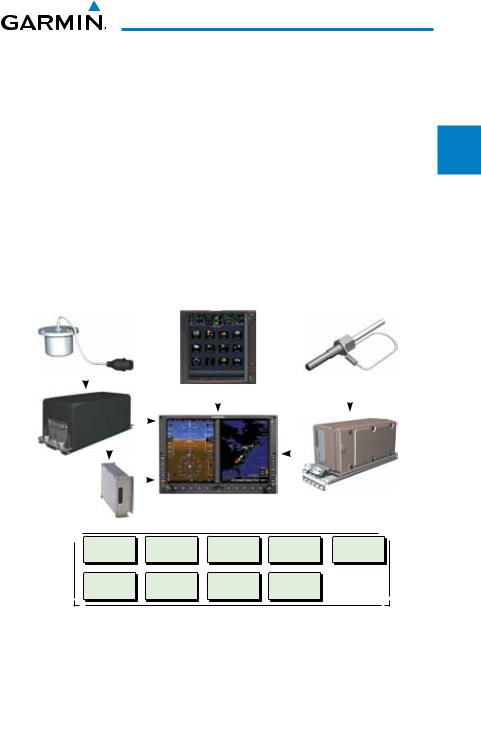
1 SYSTEM OVERVIEW
1.1System Description
This section provides an overview of the G500 Avionics Display System. The G500 system is an integrated display system that presents primary flight instrumentation, navigation, and a moving map to the pilot through largeformat displays.
In normal operating mode, the Primary Flight Display (PFD) presents graphical flight instrumentation (attitude, heading, airspeed, altitude, vertical speed), replacing the traditional flight instrument cluster. The Multi-Function Display (MFD) normally displays a full-color moving map with navigation information, as well as supplemental data.
GMU 44 Magnetometer |
Garmin Navigator(s) |
GTP 59 Temperature Probe |
|
|
|
|
|
|
|
GDU 620 |
|
|
|
|
|
|
|
|
|
|
|
|
|
|
|
|
|
|
|
|
|
|
|
|
|
|
|
|
|
|
|
|
|
|
|
|
|
|
|
|
|
|
|
|
||
|
|
|
|
|
|
|
|
|
|
|
|
|
|
|
|
|
|
|
|
|
|
|
|
|
|
|
|
|
|
|
|
|
|
|
|
|
|
|
|
|
|
|
|
|
|
|
|
|
|
|
|
|
|
GRS 77 AHRS |
|
|
|
|
|
|
|
|
|
|
|
|
|||||
GAD 43/43e |
|
|
|
|
|
|
GDC 74 Air Data Computer |
||||||||||
|
|
|
|
|
|
||||||||||||
|
|
|
|
|
|
|
|
|
|
|
|
||||||
|
|
|
|
|
|
|
|
Optional Interfaces |
|
|
|
|
|
|
|
|
|
|
|
|
|
|
|
|
Autopilot |
|
|
|
|
|
|
|
|
||
|
|
|
Audio Panel |
|
|
Weather |
Traffic |
Radar |
|
|
|||||||
|
|
|
|
|
|||||||||||||
|
|
|
Flight Director |
|
Datalink |
Altimeter |
|||||||||||
|
|
|
|
|
|
|
|
|
|
||||||||
|
|
|
Navigation |
|
ADF |
|
Weather |
DME |
|
|
|
|
|
||||
|
|
|
Radio |
|
|
Radar |
|
|
|
|
|
||||||
|
|
|
|
|
|
|
|
|
|
|
|
|
|
||||
Figure 1-1 G500 System (LRU Configuration)
The system consists of the following Line Replaceable Units (LRUs):
•GDU 620 Primary Flight Display (PFD) and Multi Function Display (MFD)
•GDC 74A/74B Air Data Computer (ADC)
•GRS 77 Attitude and Heading Reference System (AHRS)
•Temperature Probe (such as the GTP 59)
Foreword |
|
|
1 Sec System |
|
|
PFD |
2 Sec |
|
3 Sec MFD |
|
|
Avoidance |
Hazard |
4 Sec |
Features |
Additional |
5 Sec |
Alerts & |
.Annun |
6 Sec |
Symbols |
7 Sec |
|
Glossary |
8 Sec |
|
A Appendix |
|
|
Index |
Appendix |
|
|
B |
|
190-01102-02 Rev. E |
Garmin G500 Pilot’s Guide |
1-1 |

|
|
Foreword |
|
|
|
|
Sec 1 |
System |
|
|
|
|
Sec 2 |
PFD |
|
Sec 3 |
MFD |
Sec 4 |
Hazard |
Avoidance |
Sec 5 |
Additional |
Features |
Sec 6 |
Annun. & Alerts |
|
|
Sec 7 |
Symbols |
|
Sec 8 |
Glossary |
|
|
Appendix A |
|
Appendix B |
Index |
•GMU 44 Magnetometer
•Atleastoneofthefollowing: GNS 480, CNX80, GNS 400W series, GNS 500W series, GTN 600 series, GTN 700 series, or a compatible GPS Navigator
•GAD 43/43e Adapter (Optional)
Interfaces to various other aircraft systems and equipment are supported, including:
•GDL 69/69A Satellite Data Link Receiver
•GSR 56 Satellite Data Link Receiver
•SL30 NavCom
•Autopilot/Flight Director
•ADF
•Garmin GTS or GTX traffic awareness systems, or selected 3rd party devices
•Audio Panel
•Garmin GWX radar systems or selected 3rd party radars
•Radar Altimeter
•Video Sources
1.1.1Line Replaceable Units (LRU)
This guide covers the operation of the GDU 620 display as integrated in the G500 system. The G500 Avionics Display System is an avionics suite designed to replace the traditional flight instrument cluster. The system combines primary flight instrumentation, navigational information, and a moving map all displayed on dual color screens. The G500 system is composed of sub-units or Line Replaceable Units (LRUs). LRUs have a modular design and can be installed directly behind the instrument panel or in a separate avionics bay if desired. This design greatly eases troubleshooting and maintenance of the G500 system. A failure or problem can be isolated to a particular LRU, which can be replaced quickly and easily. Each LRU has a particular function, or set of functions, that contributes to the system’s operation.
1-2 |
Garmin G500 Pilot’s Guide |
190-01102-02 Rev. E |
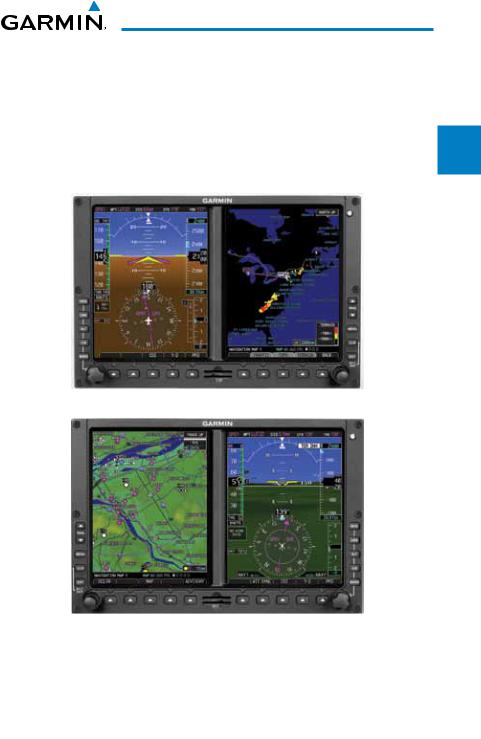
1.1.2GDU 620
The GDU 620 has dual VGA (640 x 480 pixels) 6.5 inch LCD displays. The left side of the GDU is a PFD and the right side is the MFD. In some models or installations, the PFD and MFD and their controls are switched to the other side. The MFD shows a moving map, flight plan, weather, and other supplemental data. The PFD shows primary flight information, in place of traditional pitotstatic and gyroscopic systems and also provides an HSI for navigation.
Figure 1-2 GDU 620 PFD and MFD
Figure 1-3 GDU 620 PFD and MFD with PFD on Right
Foreword |
|
|
1 Sec System |
|
|
PFD |
2 Sec |
|
3 Sec MFD |
|
|
Avoidance |
Hazard |
4 Sec |
Features |
Additional |
5 Sec |
Alerts & |
.Annun |
6 Sec |
Symbols |
7 Sec |
|
Glossary |
8 Sec |
|
A Appendix |
|
|
Index |
Appendix |
|
|
B |
|
190-01102-02 Rev. E |
Garmin G500 Pilot’s Guide |
1-3 |

|
|
Foreword |
|
|
|
|
Sec 1 |
System |
|
|
|
|
Sec 2 |
PFD |
|
Sec 3 |
MFD |
Sec 4 |
Hazard |
Avoidance |
Sec 5 |
Additional |
Features |
Sec 6 |
Annun. & Alerts |
|
|
Sec 7 |
Symbols |
|
Sec 8 |
Glossary |
|
|
Appendix A |
|
Appendix B |
Index |
1.1.3GDC 74A
The GDC 74A Air Data Computer (ADC) compiles information from the pitot/static system and an Outside Air Temperature (OAT) sensor. The GDC 74A provides pressure altitude, airspeed, vertical speed, and OAT information to the G500 system. The GDC 74A communicates with the GDU 620 and GRS 77 using an ARINC 429 digital interface.
Figure 1-4 GDC 74A Air Data Computer
1.1.4GRS 77
The GRS 77 is an Attitude and Heading Reference System (AHRS) unit that provides aircraft attitude information to the G500 display. The unit contains advanced tilt sensors, accelerometers, and rate sensors. In addition, the GRS 77 interfaces with both the GDC 74A Air Data Computer and the GMU 44 magnetometer. The GRS 77 also utilizes GPS data forwarded from the GDU 620. Actual attitude and heading information is sent to the GDU 620 using an ARINC 429 digital interface.
Figure 1-5 GRS 77 AHRS
The IGRF (International Geomagnetic Reference Field) model is contained in the GRS 77 and is only updated once every five years. The IGRF model is part of the Navigation Database. At system power-up, the IGRF models in the GRS 77 and in the Navigation Database are compared, and if the IGRF model in the GRS 77 is out of date, the user is prompted to update the IGRF model in the GRS 77. The prompt will appear after the G500 splash screen is acknowledged on the MFD.
1-4 |
Garmin G500 Pilot’s Guide |
190-01102-02 Rev. E |
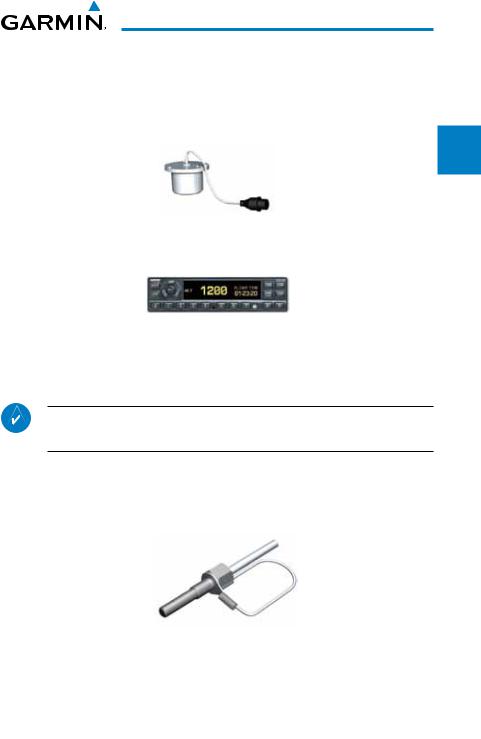
1.1.5GMU 44
The GMU 44 magnetometer senses the earth’s magnetic field. Data is sent to the GRS 77 AHRS for processing to determine aircraft magnetic heading. This unit receives power directly from the GRS 77 and communicates with the GRS 77 using a RS-485 digital interface.
Figure 1-6 GMU 44 Magnetometer
1.1.6GTX 330/330D (Optional)
Figure 1-7 GTX 330/330D Mode S Transponder
The GTX 330/330D is a solid-state transponder that provides Modes A, C, and S functions. The transponder provides traffic information to the display through an ARINC 429 digital interface.
NOTE: GTX 33/33D can also be used to display traffic information on the GDU 620.
1.1.7GTP 59
The GTP 59 temperature probe provides Outside Air Temperature (OAT) data to the GDC 74A.
Figure 1-8 GTP 59 Temperature Probe
1.1.8GSR 56
The GSR 56 is an Iridium® satellite transceiver that supports voice telephone calls, aircraft position reporting, and world wide weather products.
Foreword |
|
|
1 Sec System |
|
|
PFD |
2 Sec |
|
3 Sec MFD |
|
|
Avoidance |
Hazard |
4 Sec |
Features |
Additional |
5 Sec |
Alerts & |
.Annun |
6 Sec |
Symbols |
7 Sec |
|
Glossary |
8 Sec |
|
A Appendix |
|
|
Index |
Appendix |
|
|
B |
|
190-01102-02 Rev. E |
Garmin G500 Pilot’s Guide |
1-5 |
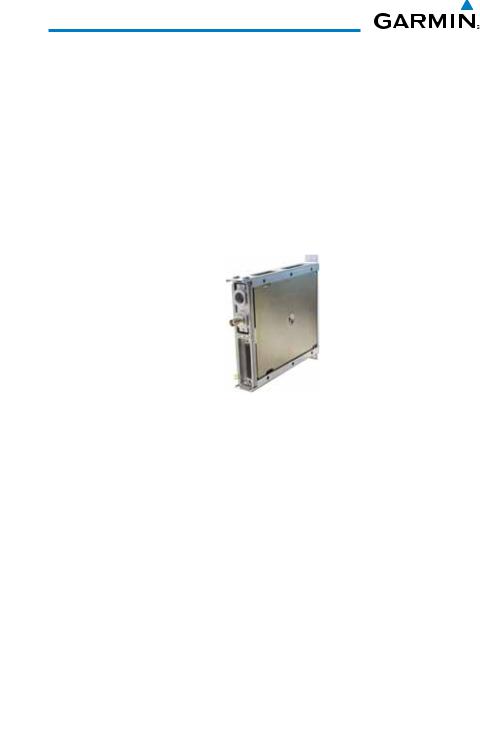
|
|
Foreword |
|
|
|
|
Sec 1 |
System |
|
|
|
|
Sec 2 |
PFD |
|
Sec 3 |
MFD |
Sec 4 |
Hazard |
Avoidance |
Sec 5 |
Additional |
Features |
Sec 6 |
Annun. & Alerts |
|
|
Sec 7 |
Symbols |
|
Sec 8 |
Glossary |
|
|
Appendix A |
|
Appendix B |
Index |
1.1.9GDL 69/69A (Optional)
The GDL 69/69A is a Sirius XM Satellite Radio Data Link Receiver that receives broadcast weather data. The GDL 69A is the same as the GDL 69 with the addition of an Sirius XM Satellite Radio audio entertainment receiver. Weather data and control of audio channel and volume is displayed on the MFD, via a High-Speed Data Bus (HSDB) Ethernet connection. The GDL 69A is also interfaced to an audio panel for distribution of the audio signal. A subscription to the Sirius XM Satellite Radio service is required to enable the GDL 69/69A capability.
Subscription information is available at: http://www.garmin.com/xm/.
Figure 1-9 GDL 69/69A XM Satellite Radio Data Link Receiver
1.1.10GAD 43(e) (Optional)
The GAD 43 is an adapter that converts AHRS digital pitch, roll, heading and yaw rate data into analog signals used by autopilot systems. The GAD 43 is installed remotely between the AHRS and an existing autopilot. The analog signals from the GAD 43 mimic those of spinning-mass gyros that provide data to the autopilot and allow the gyro to be replaced by the AHRS and GAD 43 combination.
The GAD 43e performs the same functions as the GAD 43, but adds support for additional interfaces to various aircraft systems. The GAD 43e supports interfaces to various autopilots (for altitude preselect and vertical speed control), analog NAV radios, DME, analog radar altimeters, marker beacons, and ADF receivers.
1-6 |
Garmin G500 Pilot’s Guide |
190-01102-02 Rev. E |

Figure 1-10 GAD 43 AHRS Adapter
1.1.11Weather Radar
The Garmin GWX system, or selected 3rd party radar, provides airborne weather and ground mapped radar data to the MFD.
Figure 1-11 GWX 68 Weather Radar
1.1.12Garmin Navigator Interface
The G500 system requires connection to at least one external Garmin WAAS GPS navigator, such as the 400W/500W series or GNS 480.
1.1.13Attitude Heading Reference System (AHRS)
NOTE: Aggressive maneuvering while AHRS is not operating in normal mode may degrade AHRS accuracy.
Attitude and heading information is displayed on the PFD when the AHRS receives appropriate combinations of information from the external sensor inputs.
Foreword |
|
|
1 Sec System |
|
|
PFD |
2 Sec |
|
3 Sec MFD |
|
|
Avoidance |
Hazard |
4 Sec |
Features |
Additional |
5 Sec |
Alerts & |
.Annun |
6 Sec |
Symbols |
7 Sec |
|
Glossary |
8 Sec |
|
A Appendix |
|
|
Index |
Appendix |
|
|
B |
|
190-01102-02 Rev. E |
Garmin G500 Pilot’s Guide |
1-7 |
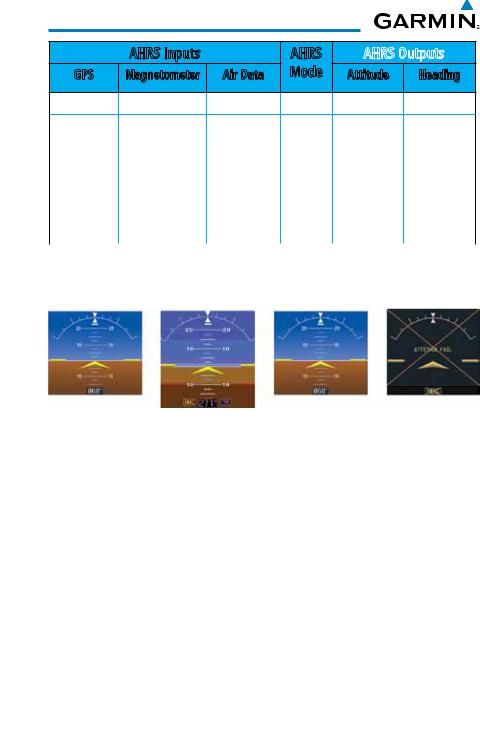
|
|
AHRS Inputs |
|
AHRS |
AHRS Outputs |
||
Foreword |
GPS |
Magnetometer |
Air Data |
Mode |
Attitude |
Heading |
|
Available |
Available |
— |
Normal |
Available |
Available |
||
|
|||||||
|
Sec1 |
System |
Available |
Unavailable |
Available |
No Mag |
Available |
|
GPS Track |
|
|
|
Available |
Unavailable |
Unavailable |
No Air/ |
Available |
|
GPS Track |
||||
|
|
|
|
||||||||
|
|
|
|
|
|
No Mag |
|
|
|
|
|
|
Sec 2 |
|
Unavailable |
Available |
Available |
No GPS |
Available |
|
Available |
|
|
|
PFD |
Unavailable |
Available |
Unavailable |
Fail |
Unavailable |
Unavailable |
|
|||
|
|
|
Unavailable |
Unavailable |
— |
Fail |
Unavailable |
Unavailable |
|||
|
Sec 3 |
MFD |
|
|
Table 1-1 AHRS Operation |
|
|
|
|
|
|
|
AHRS Normal |
Heading |
AHRS No-GPS |
Altitude/Heading |
|||||||
|
|
|
|||||||||
|
|
|
Operation |
Invalid |
Mode |
|
|
Invalid |
|||
Sec 4 |
Hazard Avoidance |
|
|
|
|
|
|
|
|
|
|
Sec 5 |
Additional |
Features |
|
|
Figure 1-12 AHRS Operation |
|
|
|
|
|
|
|
|
|
|
|
|
|
|
|
|
||
Sec 6 |
Annun. |
& Alerts |
Loss of GPS, magnetometer, or air data inputs is communicated to the pilot by |
||||||||
message advisory alerts (refer to Section 6 for specific AHRS alert information). |
|||||||||||
|
|
|
Any failure of the internal AHRS inertial sensors results in loss of attitude and |
||||||||
|
Sec7 |
Symbols |
heading information (indicated by red “X” flags over the corresponding flight |
||||||||
|
instruments). |
|
|
|
|
|
|
|
|
||
|
|
|
|
|
|
|
|
|
|
|
|
|
|
|
A maximum of two GPS inputs are provided to the AHRS. If GPS information |
||||||||
|
Sec 8 |
Glossary |
from one of the inputs fails, the AHRS uses the remaining GPS input and an |
||||||||
|
alert message is issued to inform the pilot. If both GPS inputs fail, the AHRS |
||||||||||
|
|
|
|||||||||
|
|
|
will continue to provide attitude and heading information to the PFD as long as |
||||||||
|
|
A |
magnetometer and airspeed data are available and valid. |
|
|
|
|
||||
|
|
Appendix |
If the magnetometer input fails, the AHRS continues to output valid attitude |
||||||||
|
|
|
|||||||||
|
|
|
information and GPS Track information is used; however, the heading display |
||||||||
|
B |
Index |
on the PFD is flagged as invalid with a red “X,” “TRK” in magenta is annunciated |
||||||||
|
Appendix |
to the right of the Track value, and the Track value color is changed from white |
|||||||||
|
|
|
|||||||||
|
|
|
to magenta. |
|
|
|
|
|
|
|
|
|
|
|
1-8 |
|
Garmin G500 Pilot’s Guide |
|
|
190-01102-02 Rev. E |
|||
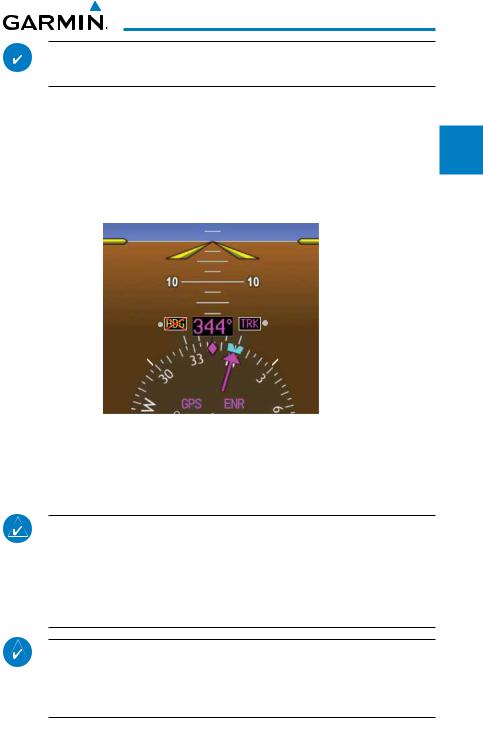
NOTE: In this case the magnetic standby compass and GPS ground track can be used to keep the aircraft on the desired heading.
Note that SVT is turned off in “track-based reversionary mode” and must be manually re-enabled when heading is restored. Also, map orientations change from HDG UP to TRACK UP and must be manually changed back after heading is restored.
When heading fails the heading bug is not removed and the GDU continues driving the autopilot heading error output using track in place of heading.
Heading Failed |
|
|
|
Track Mode Active |
|
|
SVT Is Turned Off
 When Heading
When Heading
Fails
Figure 1-13 Track Mode shown as Active when Heading Info has failed
Failure of the air data input has no effect on the AHRS output while AHRS is receiving valid GPS information. Invalid or unavailable airspeed data in addition to complete GPS failure results in loss of all attitude and heading information.
NOTE: Fastest AHRS alignment is achieved with the aircraft stationary and with all AHRS inputs valid (3-D GPS position, magnetometer, and air data). During initial power up on the ground, no GPS position and/or magnetic anomalies are common. If the aircraft is taxied prior to AHRS alignment, alignment may be delayed until after a valid 3-D GPS position is available.
NOTE: During in-flight alignment of the AHRS, minimize aircraft maneuvering. The AHRS will align with shallow banking and pitch angles (less than 20 degrees of roll or 5 degrees of pitch). AHRS alignment may not be possible during more aggressive maneuvers.
Foreword |
|
|
1 Sec System |
|
|
PFD |
2 Sec |
|
3 Sec MFD |
|
|
Avoidance |
Hazard |
4 Sec |
Features |
Additional |
5 Sec |
Alerts & |
.Annun |
6 Sec |
Symbols |
7 Sec |
|
Glossary |
8 Sec |
|
A Appendix |
|
|
Index |
Appendix |
|
|
B |
|
190-01102-02 Rev. E |
Garmin G500 Pilot’s Guide |
1-9 |
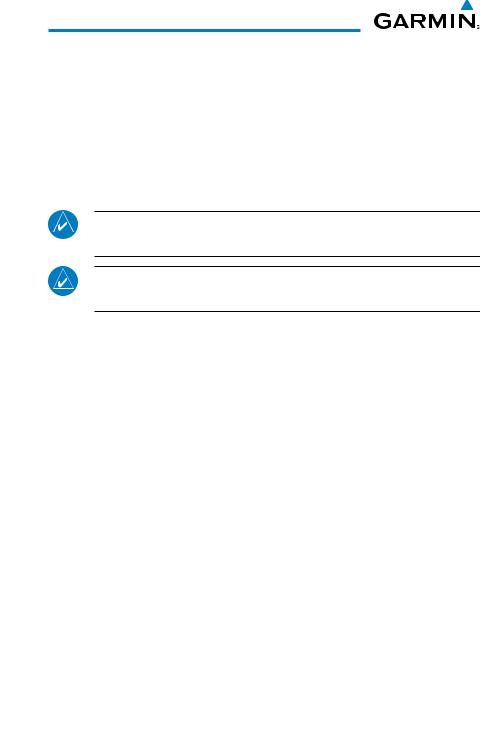
|
|
Foreword |
|
|
|
|
Sec 1 |
System |
|
|
|
|
Sec 2 |
PFD |
|
Sec 3 |
MFD |
Sec 4 |
Hazard |
Avoidance |
Sec 5 |
Additional |
Features |
Sec 6 |
Annun. & Alerts |
|
|
Sec 7 |
Symbols |
|
Sec 8 |
Glossary |
|
|
Appendix A |
|
Appendix B |
Index |
1.1.14Secure Digital Cards
The G500 System uses Secure Digital (SD) cards to load and store various types of data. For basic flight operations, SD cards are required for Terrain, Obstacle, FliteChart, SafeTaxi, and ChartView database storage as well as Jeppesen aviation and ChartView database updates. The Aviation Database update card is generally inserted in the upper SD card slot for database updates and then removed. Other database cards are normally located in the lower SD card slot. ChartView is an optional feature that requires enablement by a Garmin dealer.
NOTE: Ensure the GDU 620 is powered off before inserting or removing an SD card.
NOTE: Refer to Appendix A for instructions on updating the aviation database.
Inserting an SD Card
1)Insert the SD card in the SD card slot (the front of the card should be flush with the face of the display bezel).
2)To eject the card, gently press on the SD card to release the spring latch.
1-10 |
Garmin G500 Pilot’s Guide |
190-01102-02 Rev. E |

1.2System Power Up
NOTE: See the Aircraft Flight Manual (AFM) for specific procedures concerning avionics power application and emergency power supply operation.
NOTE: Refer to Section 6 for system-specific annunciations and alerts.
The G500 System is integrated with the aircraft electrical system and receives power directly from electrical busses. The GDU 620 and supporting sub-systems include both power-on and continuous built-in test features that exercise the processor, memory, external inputs, and outputs to ensure safe operation.
During system initialization, test annunciations are displayed. All system annunciations should disappear typically within the first 30 seconds after powerup. Upon power-up, bezel key backlights also become momentarily illuminated on the GDU 620 display bezel.
On the PFD, the AHRS begins to initialize and “AHRS ALIGN: Keep Wings Level” is displayed. The AHRS should display valid attitude and heading fields typically within the first minute after power-up. The AHRS can align itself both while taxiing and during level flight.
NOTE: Fastest AHRS alignment is achieved with the aircraft stationary and with all AHRS inputs valid (3-D GPS position, magnetometer, and air data). During initial power up on the ground, no GPS position and/or magnetic anomalies are common. If the aircraft is taxied prior to AHRS alignment, alignment may be delayed until after a valid 3-D GPS position is available.
NOTE: During in-flight alignment of the AHRS, minimize aircraft maneuvering. The AHRS will align with shallow banking and pitch angles (less than 20 degrees of roll or 5 degrees of pitch). AHRS alignment may not be possible during more aggressive maneuvers.
Foreword |
|
|
1 Sec System |
|
|
PFD |
2 Sec |
|
3 Sec MFD |
|
|
Avoidance |
Hazard |
4 Sec |
Features |
Additional |
5 Sec |
Alerts & |
.Annun |
6 Sec |
Symbols |
7 Sec |
|
Glossary |
8 Sec |
|
A Appendix |
|
|
Index |
Appendix |
|
|
B |
|
190-01102-02 Rev. E |
Garmin G500 Pilot’s Guide |
1-11 |
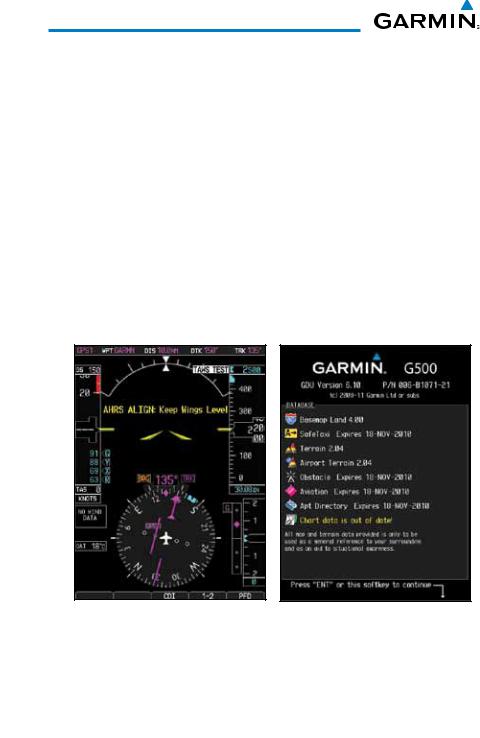
|
|
Foreword |
|
|
|
|
Sec 1 |
System |
|
|
|
|
Sec 2 |
PFD |
|
Sec 3 |
MFD |
Sec 4 |
Hazard |
Avoidance |
Sec 5 |
Additional |
Features |
Sec 6 |
Annun. & Alerts |
|
|
Sec 7 |
Symbols |
|
Sec 8 |
Glossary |
|
|
Appendix A |
|
Appendix B |
Index |
When the MFD powers up, the splash screen displays the following information:
•Software version and part number
•Basemap database version
•Terrain database version
•Airport Terrain database version
•Obstacle database expiration date
•Aviation database expiration date
•Airport Directory database expiration date
•Chart database status
Databases are displayed in white if they are determined to be current. Databases are displayed in yellow if they have expired, are not yet effective, or if the current date/time is not yet available from the GPS.
Figure 1-14 System Startup Pages
Pressing the ENT key (or right-most soft key) acknowledges this information and displays the Navigation Map Page. When the interfaced GPS unit has acquired a sufficient number of satellites to determine a position, the aircraft’s current position is shown on the Navigation Map Page.
1-12 |
Garmin G500 Pilot’s Guide |
190-01102-02 Rev. E |

1.3International Geomagnetic Reference Field
The IGRF (International Geomagnetic Reference Field) model is contained in the GRS 77 and is only updated once every five years. The IGRF model is part of the Navigation Database. At system power-up, the IGRF models in the GRS 77 and in the Navigation Database are compared, and if the IGRF model in the GRS 77 is out of date, the user is prompted to update the IGRF model in the GRS 77. The following prompt will appear after the G500 splash screen is acknowledged on the MFD.
GRS MV DB UPDATE AVAILABLE. UPDATE FROM yyyy TO yyyy (e.g. 2005 to 2010)
Follow the on-screen instructions.
1)When the Update message appears, to start the update process press the ENT key with “OK” highlighted. To update at another time, turn the Large knob to highlight “Cancel” and then press ENT.
Figure 1-15 GRS MV DB Update
2) After the update is complete, press the ENT key to continue normal operation.
Foreword |
|
|
1 Sec System |
|
|
PFD |
2 Sec |
|
3 Sec MFD |
|
|
Avoidance |
Hazard |
4 Sec |
Features |
Additional |
5 Sec |
Alerts & |
.Annun |
6 Sec |
Symbols |
7 Sec |
|
Glossary |
8 Sec |
|
A Appendix |
|
|
Index |
Appendix |
|
|
B |
|
190-01102-02 Rev. E |
Garmin G500 Pilot’s Guide |
1-13 |
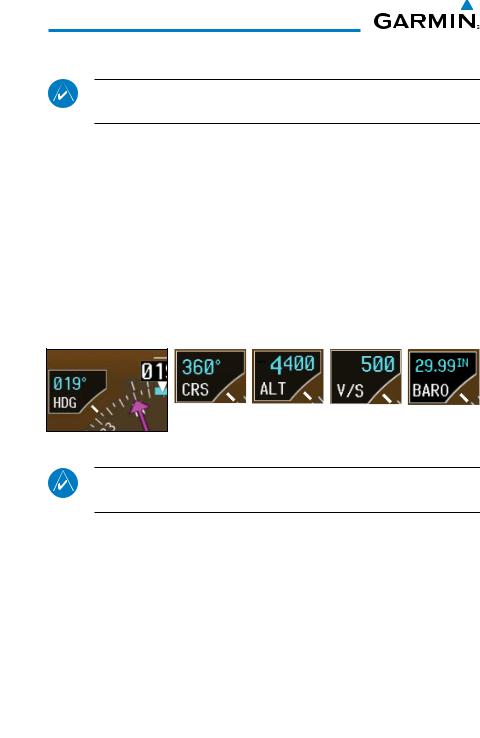
|
|
Foreword |
|
|
|
|
Sec 1 |
System |
|
|
|
|
Sec 2 |
PFD |
|
Sec 3 |
MFD |
Sec 4 |
Hazard |
Avoidance |
Sec 5 |
Additional |
Features |
Sec 6 |
Annun. & Alerts |
|
|
Sec 7 |
Symbols |
|
Sec 8 |
Glossary |
|
|
Appendix A |
|
Appendix B |
Index |
1.4System Operation
NOTE: Refer to Section 6 for detailed descriptions of all alerts and annunciations.
1.4.1Pilot Controls
The GDU 620 controls have been designed to simplify operation of the system and minimize workload and the time required to access functionality. Controls are located on the PFD and MFD bezels and are comprised of a PFD knob, MFD dual concentric knobs, bezel keys, and soft keys.
1.4.1.1PFD Knob
Pressing the PFD knob performs the default action for the selected mode. Refer to the PFD Bezel Keys section for details.
Heading |
Course |
Altitude |
|
Vertical Speed |
|
Barometer |
|
Mode |
Mode |
Mode |
|
Mode |
|
Mode |
|
|
|
|
|
|
|
|
|
Figure 1-16 Selection Modes Adjusted with the PFD Knob
NOTE: After 10 seconds of inactivity in another mode, the PFD knob selected mode will revert to Heading mode.
1.Press the desired PFD mode selection key (HDG, CRS, ALT, V/S, or BARO). A window will be displayed near the upper left corner of the HSI showing the current value for that mode.
2.Turn the PFD knob to select the desired value.
1-14 |
Garmin G500 Pilot’s Guide |
190-01102-02 Rev. E |
